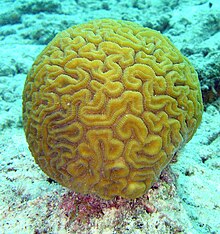Brain corals are one of the most intriguing marine creatures found in tropical oceans. Named for their grooved, brain-like appearance, these corals form massive, dome-shaped colonies that serve as both architectural wonders of nature and essential habitats for ocean life. In this article, we’ll explore what brain corals are, how they grow, their ecological importance, and the threats they face.
What Are Brain Corals?
Brain corals are a type of hard coral belonging to the family Mussidae or Merulinidae. Their signature ridged and grooved surfaces closely resemble the folds of the human brain. These structures are made up of thousands of tiny polyps—soft-bodied organisms that live together in colonies and create calcium carbonate skeletons that form the coral reef structure.
Structure and Living Mechanism of Brain Corals
1. Coral Polyps
Each brain coral is composed of numerous small polyps. These polyps are tube-shaped animals with tentacles they use to capture plankton and other microscopic food particles from the water. Over time, the polyps secrete calcium carbonate, gradually building the hard skeleton that defines the coral’s shape.
2. Symbiosis with Zooxanthellae Algae
Brain coral polyps host microscopic algae called zooxanthellae inside their tissues. These algae perform photosynthesis, providing energy to the coral in the form of sugars. In return, the coral offers the algae a safe environment and access to sunlight. This mutually beneficial relationship is critical to the survival of both organisms and allows the coral to thrive in shallow, sunlit waters.
Growth and Reproduction of Brain Corals
Brain corals grow slowly, often only 1–6 inches (2.5–15 cm) per year, depending on conditions. This slow growth makes them particularly vulnerable to damage.
Brain corals reproduce both sexually and asexually:
-
Sexual reproduction involves the release of eggs and sperm into the water column. Fertilization occurs in open water, and the resulting larvae eventually settle onto a surface to form new coral colonies.
-
Asexual reproduction allows individual polyps to clone themselves, expanding the colony without external fertilization.
Ecological Importance of Brain Corals
Brain corals play a critical role in marine ecosystems:
-
Habitat creation: These corals provide shelter for a wide variety of marine life, from tiny shrimp to large fish species.
-
Coastal protection: Coral reefs help buffer shorelines from waves and storm surges, reducing erosion and damage.
-
Biodiversity support: Coral reefs, including those formed by brain corals, host an estimated 25% of all marine species.
Threats to Brain Corals
Unfortunately, brain corals face a variety of environmental threats:
-
Climate change: Rising sea temperatures cause coral bleaching—a stress response where corals expel their zooxanthellae, leading to potential coral death.
-
Pollution: Runoff containing chemicals, plastics, and sediments can harm coral polyps and reduce sunlight penetration.
-
Overharvesting: Collecting brain corals for decorative or medicinal purposes depletes natural populations.
Coral Conservation Efforts
To protect brain corals and coral reefs in general, several actions are necessary:
-
Establishing marine protected areas: Setting aside zones where fishing, anchoring, and other damaging activities are restricted can allow corals to recover.
-
Public awareness and education: Teaching local communities and tourists about the importance of coral ecosystems encourages more responsible behavior.
-
Sustainable management: Implementing regulations on coral harvesting and promoting reef-friendly tourism practices are key to long-term conservation.
Conclusion
Brain corals are remarkable organisms that not only showcase the beauty of nature but also support the health of entire marine ecosystems. Understanding their biology, importance, and the threats they face is essential for preserving them for future generations. With informed conservation efforts and public engagement, we can protect these underwater marvels and ensure their survival in a changing world.
Refrences:

